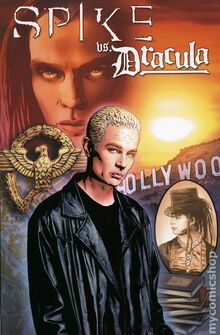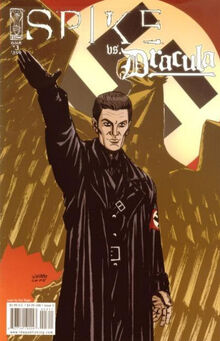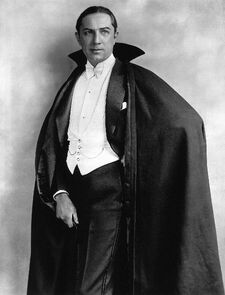
Corroney, Joe. Spike vs. Dracula Cover #1A. Digital image. My Comic Shop.
Spike vs. Dracula is a five-part comic book series from 2006 written by Peter David and illustrated by Joe Corroney. The series is based on characters from the television show Buffy the Vampire Slayer. Each issue chronicles the ongoing feud between Spike and Dracula during the 19th, 20th, and 21st centuries.
Summary[]
Spike vs. Dracula #1 []
The first issue opens at then end of October 1897, just six months after the first publication of Bram Stoker's novel Dracula. In a narrative device that will be repeated throughout the rest of the series, this issue uses letters written by Dracula which retell the events that spawned the century-long rivalry between himself and fellow vampire Spike. Dracula is enamored by a Romani sorceress named Magda and does everything he can to convince her to join him as a vampire. One day, Dracula discovers that Magda and her entire clan has been slaughtered, and quickly identifies the killers as the vampires Spike, Drusilla, and Darla.
The setting shifts to a bookstore wherein Spike and Drusilla discuss and ridicule a signed copy of Dracula, which Drusilla asks Spike to purchase. He pays eleven pounds for the novel, a reoccurring point of contention for Spike in both the comics and the Buffy episode "Buffy vs. Dracula."
Meanwhile, Dracula successfully hypnotizes Darla, and takes her to his home so that she can become his bride. Spike and Drusilla arrive in order to save their friend, and Spike attempts to fight Dracula. However, Dracula temporarily succeeds, and, while Spike runs from the home, Dracula takes the two women with him in his carriage.
Spike discovers Dracula's location, and incites the local townspeople into an angry mob who attack Dracula and his mansion, as Spike takes the women and flees.
Spike vs. Dracula #2[]
Issue number two begins nearly forty years later, in October 1937. This section effortlessly combines three narrative strains: Darla is staying in Germany reading a letter from Spike; a young boy in Poughkeepsie, New York retells his experience at a stage production of Dracula; and Spike and Drusilla spend time in Los Angeles chasing after Count Dracula.
In Los Angeles, Spike and Drusilla have tickets to see Bela Lugosi's performance as Dracula on stage. Also in attendance is Count Dracula, who, throughout the play, becomes visibly more agitated by Lugosi's portrayal. Count Dracula's vanity sufficiently slighted, he decides to attack Lugosi in his dressing room after the play. True to fashion, Spike shows up just in time to save Lugosi before he is killed, but is unable to stop Dracula from transforming into a bat and flying away.

Wright, Eric. Spike vs Dracula Cover #3D. Digital image. My Comic Shop.
Spike vs. Dracula # 3[]
Picking up nine years later, Darla is still in Germany; however, she has not responded to any of Spike's letters as of late. Worried, Spike decides to travel to Berlin. After killing a Nazi guard, Spike steals the man's uniform and enters Darla's apartment only to find Count Dracula instead.
Count Dracula informs Spike that it was Hitler's secret police that kidnapped Darla and one of Dracula's own wives. In an attempt to rescue his wife, Dracula proposes an alliance. Using Dracula's knowledge of German and Spike's penchant for violence, the two are able to infiltrate the Nazi stronghold to save the women.
While Spike fights and distracts the Nazis, Dracula quietly escapes with both Darla and his wife. Spike finds a letter left by Darla which reveals that she is on her way back to London, while Dracula and his wife return to Romania.
Concurrently, Dracula discusses another alliance, this time, with Adolph Hitler. In exchange for the freedom of some gyspy tribes, Dracula will divulge the location of what he refers to as "three of the most formidable" vampires that exist (69).
Spike vs. Dracula #4[]
The penultimate issue is a short, diverting section that has little action between Spike and Dracula, and instead, focuses on Spike, Drusilla, and the enigmatic Comte de Saint-Germain. It is 1959, and while at a party, Drusilla disappears. A party goer says she interested a man named "Le Comte," meaning "The Count," which Spike assumes refers to Count Dracula. Shortly after leaving the party, Spike is drugged by a group of demons, ostensibly the henchmen of Count Dracula. Spike is more powerful than the tranquilizers, and is able to manipulate the demons into taking him to the Count.
The man that Spike meets, however, is not Count Dracula, but the aforementioned Comte de Saint-Germain. He is celebrating his 200th birthday celebration, and desired Drusilla for her company - which is purely musical and social, not sexual. The demons work for him, and were meant to distract Spike while Drusilla was away. After leaving the mansion, Spike destroys a large statue that resembles Count Dracula, which is positioned in the Comte's yard. The statue releases the spirit of Dracula, who seemingly bites the Comte for having imprisoned him for twelve years.
Spike vs. Dracula #5[]
Spike and Dracula's feud reaches its conclusion in November 2003, in Los Angeles. Spike learns from Angel that Dracula is coming to visit the offices of Wolfram and Hart to discuss the destruction of his expensive mansion in Sunnydale. At this point, Spike is in the form of the ghost, and is eager to use this liminality to play with Dracula's mind.
Once Dracula arrives, Spike accosts and taunts him, but Dracula's attention soon shifts to Angel. After Dracula discovers that it was Angel who both created Spike and was responsible for the killing of Magda years ago, Dracula informs Spike that their rivalry is over, and that a new rivalry with Angel has just begun. Displeased with the lack of attention, Spike tries to follow Dracula after he leaves the firm. Dracula has clearly finished with Spike's antics, and formally ends their fight by giving Spike the eleven pounds he has been demanding for the past 106 years. Ironically, Spike is unable to physically pocket the money due to his ghost-like state.
Major Themes and Ideas[]
Spike vs. Dracula is a noteworthy adaptation of the Dracula narrative not due to any measure of textual fidelity, but rather because it is a smart, post-modern look at the role of Dracula, set against the backdrop of major historical moments.
Self-Referentiality[]

Bela Lugosi on stage as Count Dracula. Digital image. Bela Lugosi Annex. Dr. Macro.
The comic series immediately situates itself as a self-referential text by setting the first comic in the first few months following the publication of Dracula. Both exist in the same space, and both are a source of conflict for other vampires. Spike is annoyed by the "mincing ponce of a Romanian vampire" and his fantastic ability to transform into other animals. Included in the text are explicit and complete steps on how to kill a vampire, which Spike finds to be "damned inconvenient" (9). For Count Dracula, the text is a source of more than inconvenience, but is a complete fabrication, a damaging piece of slander which posits Dracula as a "dithering buffoon" (14). All vampires, Dracula included, must deal with the incredible sense of awareness that society has concerning Dracula, and all of the prejudices and preconceived notions that go along with such a popular text.
In addition to the relationship that exists between the novel and vampires, there is also an awareness of the tie between adaptations and vampires. Much of the conflict in issue two stems from Count Dracula's rage over Bela Lugosi's portrayal of Dracula. Lugosi's performances both increase popular consumption of the detested novel, while simultaneously presenting a Dracula that is more charming and refined than the "real" Count.
Issue three also includes a creature named "the Prince of Lies" who both resembles and quotes famous adaptations of Dracula. He is a hunched, frightening man, with skinny fingers that resemble talons, and bushy eyebrows that overpower his face - an almost exact copy of Max Schreck's Count in Nosferatu (1922). The Prince of Lies also refers to both himself and Spike as "creatures of the night" - a line originally found in the novel, but made famous through repetition in countless Dracula adaptations (67).
Popular Culture as a Legitimizing Force[]
Much in the same way that Dracula and other novels written in the 19th century used frame narratives to establish legitimacy, so too does Spike vs. Dracula use pop culture references. Frame narratives, often compiled from letters and diary entries written by professionals, or various newspaper clippings, would mimic verisimilitude, and create a sense that the text is factual, if not at least realistic. Spike vs. Dracula employs these same techniques, but the most powerful tool is the interweaving of historical moments and the name dropping of celebrities.
In issue two, the young boy from Poughkeepsie with the powerful imagination turns out to be Edward Wood, Junior, the infamously bad B movie director. After the teacher punishes him for his outlandish story, he proclaims that he'll "make monster movies! Big, scary, gory, shockers...[with] Bela Lugosi...in them!" (48). Fans of both Lugosi and campy horror films will immediately latch onto this reference - a clever blending of a infamous director and a celebrated actor can make the reader, even for just a moment , believe the boy's excited story in the classroom.
Less developed but still referenced in the text are famous actresses Audrey Hepburn and Sophia Lauren, and musician Michael Jackson (87, 99). This act of name dropping once again situates the text in real moments in history, while simultaneously demonstrating the power of celebrity - and how pervasive characters and celebrities are in modern culture. Dracula is situated amongst these actresses and musicians in a way that speaks to his power - simply his name produces excitement and conjures a set of preconceived expectations in those who hear it.
